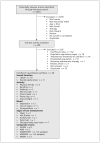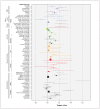Predicting low testosterone in aging men: a systematic review
- PMID: 27325129
- PMCID: PMC5026531
- DOI: 10.1503/cmaj.150262
Predicting low testosterone in aging men: a systematic review
Abstract
Background: Physicians diagnose and treat suspected hypogonadism in older men by extrapolating from the defined clinical entity of hypogonadism found in younger men. We conducted a systematic review to estimate the accuracy of clinical symptoms and signs for predicting low testosterone among aging men.
Methods: We searched the MEDLINE and Embase databases (January 1966 to July 2014) for studies that compared clinical features with a measurement of serum testosterone in men. Three of the authors independently reviewed articles for inclusion, assessed quality and extracted data.
Results: Among 6053 articles identified, 40 met the inclusion criteria. The prevalence of low testosterone ranged between 2% and 77%. Threshold testosterone levels used for reference standards also varied substantially. The summary likelihood ratio associated with decreased libido was 1.6 (95% confidence interval [CI] 1.3-1.9), and the likelihood ratio for absence of this finding was 0.72 (95% CI 0.58-0.85). The likelihood ratio associated with the presence of erectile dysfunction was 1.5 (95% CI 1.3-1.8) and with absence of erectile dysfunction was 0.83 (95% CI 0.76-0.91). Of the multiple-item instruments, the ANDROTEST showed both the most favourable positive likelihood ratio (range 1.9-2.2) and the most favourable negative likelihood ratio (range 0.37-0.49).
Interpretation: We found weak correlation between signs, symptoms and testosterone levels, uncertainty about what threshold testosterone levels should be considered low for aging men and wide variation in estimated prevalence of the condition. It is therefore difficult to extrapolate the method of diagnosing pathologic hypogonadism in younger men to clinical decisions regarding age-related testosterone decline in aging men.
© 2016 Canadian Medical Association or its licensors.
Figures



References
-
- Bhasin S, Cunningham GR, Hayes FJ, et al. Testosterone therapy in men with androgen deficiency syndromes: an Endocrine Society clinical practice guideline. J Clin Endocrinol Metab 2010;95:2536–59. - PubMed
-
- Yin A, Swerdloff R. Treating hypogonadism in younger males. Expert Opin Pharmacother 2010;11:1529–40. - PubMed
-
- Wang C, Cunningham G, Dobs A, et al. Long-term testosterone gel (AndroGel) treatment maintains beneficial effects on sexual function and mood, lean and fat mass, and bone mineral density in hypogonadal men. J Clin Endocrinol Metab 2004;89:2085–98. - PubMed
-
- Wu FC, Tajar A, Pye SR, et al. Hypothalamic–pituitary–testicular axis disruptions in older men are differentially linked to age and modifiable risk factors: the European Male Aging Study. J Clin Endocrinol Metab 2008;93:2737–45. - PubMed
Publication types
MeSH terms
Substances
LinkOut - more resources
Full Text Sources
Other Literature Sources
Medical
Miscellaneous
